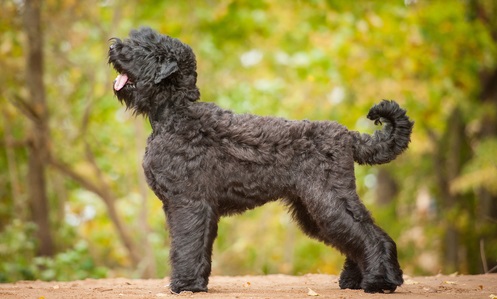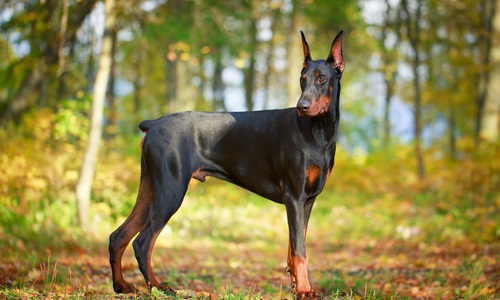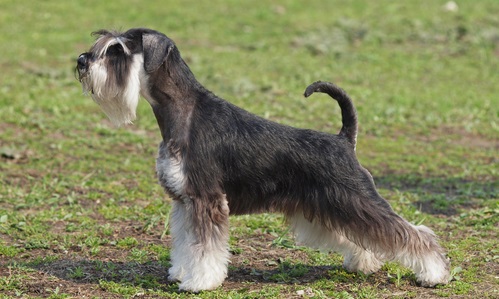From the beginning of canine domestication, man has shaped the animals once known as wolves into trustworthy companions. In addition, that evolutionary process has come in handy for a number of jobs required by humans – security of a homestead, transportation of goods, and rescuing humans from various states of distress, among other tasks. Today, this group of specially-bred canines is called the “Working Group” by the American Kennel Club, or AKC: an organization long considered the foremost authority on dog breeding.
While the term “working dog breeds” often brings herding to mind, herding breeds like the German Shepherd were spun off into their own AKC group in the 1980s. The 30 working breeds left behind in the original class comprise strong, stout examples of their genetic lines, and offer a mix of familiar, popular lineages and more exotic specific-task breeds. Below are some of the most common working breeds of dog today.
Akita: The Akita is a formidable dog, both in stature and temperament. Easily spotted by their curled tails and wide, broad heads, they are extremely strong and very protective of their owners and families. Their thick double coat, while short and straight, makes them a natural fit for cold climates.
Alaskan Malamute: The Alaskan Malamute is an extremely popular sled dog, as his thick coat, broad chest, and spitz-type curled tail help him plow through the snow without complaint. His friendly temperament makes him a natural pack dog, which comes in handy while running a sled with other dogs.
Anatolian Shepherd Dog: The Anatolian Shepherd Dog is the exception to the otherwise shepherd-light working group. Originally bred in Turkey, his body shows he’s made to tackle the tough terrain of his homeland: hills, rocky ledges, and mountain ranges are no match for his dense bone structure and skilled footing.
Bernese Mountain Dog / Saint Bernard / Greater Swiss Mountain Dog: These three breeds, while distinct in their own ways, share several points of similarity: all have a tri-colored coat and markings of white, black, and brown, all originated in Switzerland, and all are excellent in colder climates. The Saint Bernard is slightly larger than the Bernese and Greater Swiss, but only by an inch or so on average. The Greater Swiss has a shorter coat than his two lookalike “cousins,” making him a good choice for homes that prefer more sporadic grooming routines.
 Black Russian Terrier: The Black Russian Terrier has an intriguing backstory: he was secretly bred to be a “super dog” by the Russian government in the 1930s. Built to patrol fences and borders without complaint, even on cold nights, his thick, shaggy coat keeps him warm and comfortable for long hours on the job. A large dog, he comes up to 28 inches at the shoulder, enabling him to easily keep pace with his human companion during a patrol.
Black Russian Terrier: The Black Russian Terrier has an intriguing backstory: he was secretly bred to be a “super dog” by the Russian government in the 1930s. Built to patrol fences and borders without complaint, even on cold nights, his thick, shaggy coat keeps him warm and comfortable for long hours on the job. A large dog, he comes up to 28 inches at the shoulder, enabling him to easily keep pace with his human companion during a patrol.
Boerboel: His breed name comes from the Dutch words for “farmer” and “dog,” but his impressive muscular strength gives him the impression of a protector that won’t back down. The Boerboel is a short-coated dog with genetics that eventually produced the mastiff family of breeds, and the lineage shows in his broad chest, squared head profile, and sturdy, nimble stance.
Boxer: The Boxer gets his breed name from the human athlete: he, too, uses his front paws to swat, stance, and “box” during play or defense. At rest, his beautifully-muscled form shows off mastiff lineage, and his pointed, alert ears emphasize the characteristic forehead wrinkles and upturned snout. An abundance of personality and a loving nature with children make him an excellent family pet for a patient owner willing to train him.
Bull Mastiff: Originally bred to secure the estates of noblemen and their coveted game animals, the Bull Mastiff is slightly smaller than the Mastiff proper, but no less spirited. A born-and-bred watchdog, he is fiercely protective of his territory and will defend it or raise a barking alarm instinctually to summon help. This breed is still used heavily for guard companionship and watchdog duty for businesses.
Cane Corso: While some breeds are well-known for their intimidating looks, the Cane Corso is a silent, impressive addition to the ranks: his lineage was forged in Italian wars where his ancestors were sent rushing into enemy lines armed with flaming buckets of oil. That particularly specialized task created a dog that is patient, not easily “spooked,” and fearlessly loyal to his owner. The breed standard calls for cropped ears and tails.
 Doberman Pinscher / German Pinscher: The “Dobie” breed originated under interesting circumstances: he was originally bred to protect tax collectors and intimidate debtors into paying up. Today, his unmistakable silhouette makes the Doberman Pinscher the undisputed champ of guard dog-dom, with the mere sight of an alert Doberman enough to send even the most ambitious thieves scurrying the other direction. Strong, tall, and amazingly swift, he can cover large distances in a very short period of time when he’s on defense: bad news for burglars. The Doberman’s stockier cousin, the German Pinscher, performs the same duty with a little more blocky strength to his build, compared to the sleek aerodynamic lines of the Dobie.
Doberman Pinscher / German Pinscher: The “Dobie” breed originated under interesting circumstances: he was originally bred to protect tax collectors and intimidate debtors into paying up. Today, his unmistakable silhouette makes the Doberman Pinscher the undisputed champ of guard dog-dom, with the mere sight of an alert Doberman enough to send even the most ambitious thieves scurrying the other direction. Strong, tall, and amazingly swift, he can cover large distances in a very short period of time when he’s on defense: bad news for burglars. The Doberman’s stockier cousin, the German Pinscher, performs the same duty with a little more blocky strength to his build, compared to the sleek aerodynamic lines of the Dobie.
Great Dane: Among guard dogs, there’s two schools of thought: the use of small-to-medium athletic dogs with speed and precision, or large, hulking dogs that intimidate through size and the will to back it up. Great Danes are in the second group, though their breed standard cropped ears and long, broad muzzles still paint a concerning picture to would-be criminals. At 30 to 32 inches tall at the shoulder, he’s one of the largest dog breeds recognized by the AKC today.
Komondor: Known to many as the “dreadlocked dog,” the Komondor coat is a distinctive layer of white cords that rest in layers against his body, rather than traditional fur. The fur naturally mats in this manner for a reason: as a sheep-guarding breed, these cords keep him warm, allow him to deflect the teeth of predators like wolves, and also help him blend in seamlessly with his flock.
Mastiff / Neapolitan Mastiff / Tibetan Mastiff: Larger than the Bull Mastiff but still sharing the same face and head structure, the Mastiff and Neapolitan Mastiff both have the trademark stocky bodies, thick necks, short ears, and droopy jowls and chins. These powerful dogs have enough size to intimidate at a distance: 30 inches or higher at the shoulder. This height places him as a peer to the Great Dane in terms of canine stature: a guard or watchman with a Mastiff in tow is well-protected from potential criminals. The Tibetan Mastiff, a third Mastiff breed in the working dogs group, is differentiated by a voluminous coat. This coat is thought to have been bred to keep him warm in the cold winters of the Himalayan Mountains.
Portuguese Water Dog: With “water” in his breed name, it’s no surprise that the Portuguese Water Dog doesn’t shy away from service on a ship or near the shore. Capable of doing everything from chasing fish into underwater nets to helping retrieve lost sailors, his low-shedding curled coat is also ideal for land-based companionship in allergy-sensitive households. It was this trait that attracted former president Barack Obama to welcome two Portugues Water Dogs into his home, Sunny and Bo, to give his allergy-prone daughter Malia a suitable canine companion.
Siberian Husky: Where Malamutes go, Huskies aren’t far behind: the two breeds share a remarkable number of similarities in terms of appearance and physical traits. Huskies tend to have sleeker coats than Malamutes, but both breeds are generally considered “top dogs” when it comes time to select a sledding team. One of the easiest differences to spot is the tail position: Malamutes have the spitz curl-up, while Huskies tend to leave their tails hanging down like their ancestral wolf predecessors. A third working breed, the Samoyed, brings together the fluffy coat and curled tail of the Malamute with an additional cold-weather trait: an upturned “smiling” mouth that prevents ice from forming near the jowls.
 Standard Schnauzer / Giant Schnauzer: The box-like shape of their muzzles and their characteristic “beards” give Schnauzers an almost human-like quality. In fact, the breed name of these German farmer’s dogs translates to “whiskered snout.” The Standard Schnauzer comes to between 19 and 20 inches at his shoulder height, while the Giant Schnauzer is approximately half a foot taller at 24 to 26 inches at the shoulder.
Standard Schnauzer / Giant Schnauzer: The box-like shape of their muzzles and their characteristic “beards” give Schnauzers an almost human-like quality. In fact, the breed name of these German farmer’s dogs translates to “whiskered snout.” The Standard Schnauzer comes to between 19 and 20 inches at his shoulder height, while the Giant Schnauzer is approximately half a foot taller at 24 to 26 inches at the shoulder.
Several other breeds in the working dog group round out this surprisingly diverse family of dogs: the Newfoundland, Rottweiler, Leonberger, Great Pyrenees, Dogue de Bordeaux, and Chinook each bring task-based traits to the table.
While the dogs in this group naturally take to the tasks they’ve been bred for with proper training, it’s worth noting that the very same tendencies may make them difficult for a novice to train. Homes considering adding one of these hardworking canines should first do plenty of research to ensure a good breed fit: a home prepared for a spirited, personality-filled working dog is a match made in heaven for the lucky canine and his owners.
Sources Cited:
- “Working Group.” American Kennel Club (AKC.org), (no publish date), https://www.akc.org/dog-breeds/working/page/3/. Accessed November 27, 2019.
- “Working Dog Breeds.” Animal Planet.com, (no publish date), http://www.animalplanet.com/breed-selector/dog-breeds/working-dogs.html. Accessed November 27, 2019.
- Stregowski, Jenna, RVT. “7 Types of Working Dogs.” The Spruce Pets.com, May 29, 2019, https://www.thesprucepets.com/types-of-working-dogs-1118684. Accessed November 27, 2019.




